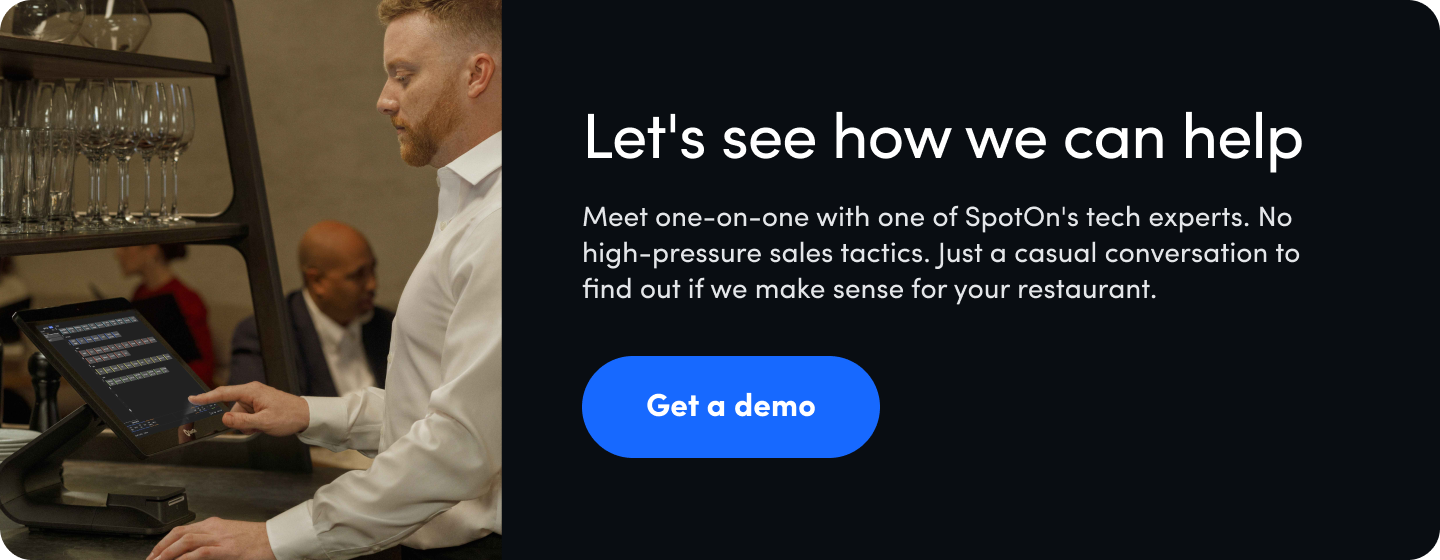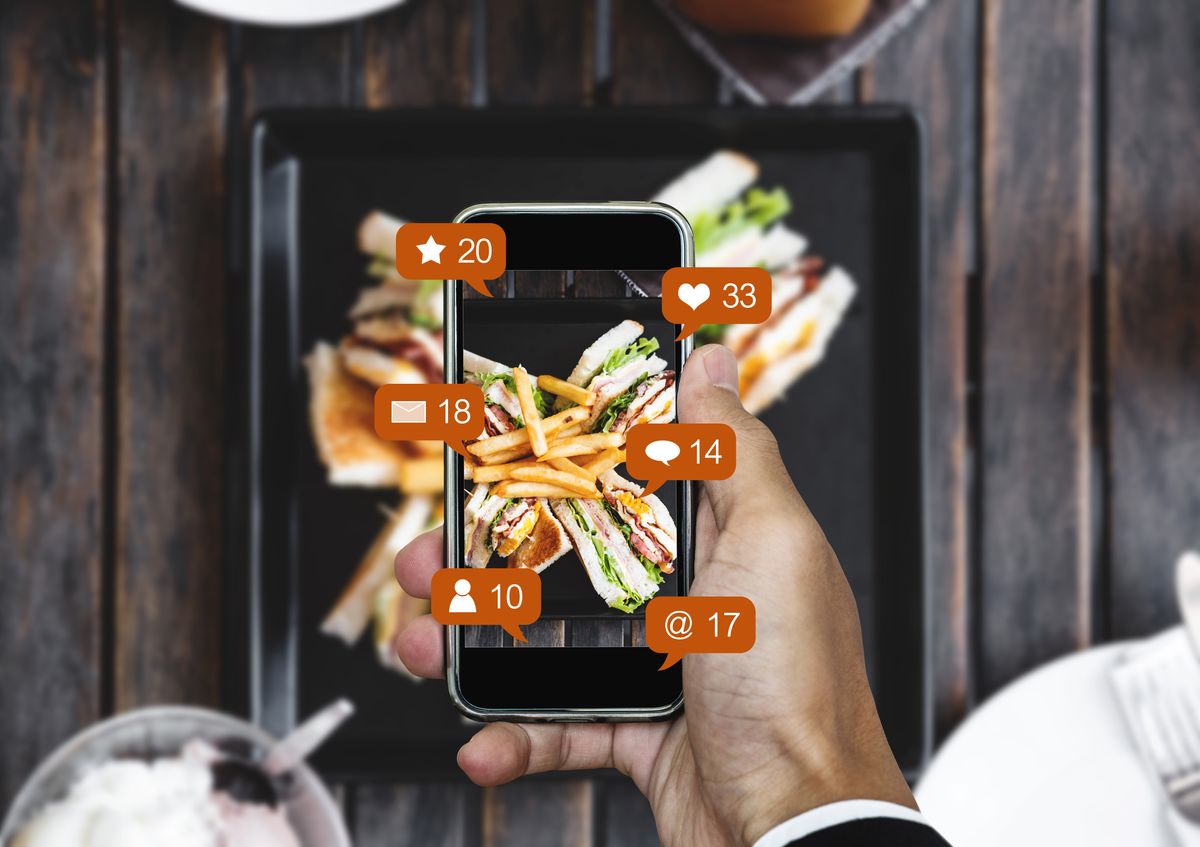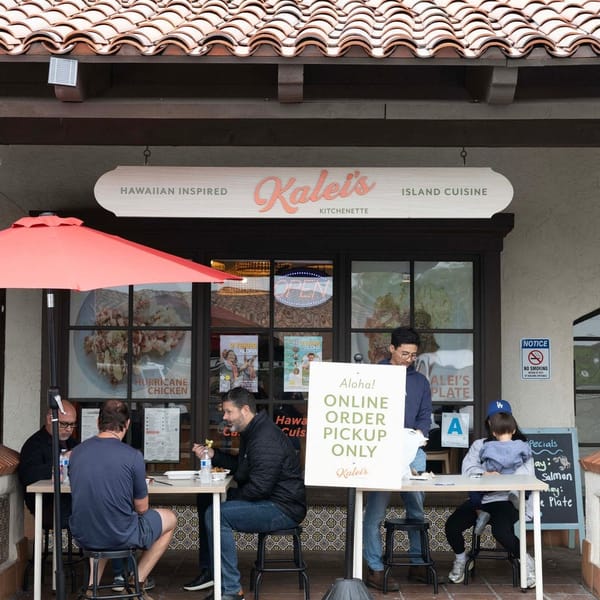You opened a restaurant. It took reams of paperwork, hours of recipe testing, and a small city's worth of people to make it happen. But no matter how timeless the decor, inventive the menu, and dialed-in your COGS may be, restaurant success will always be determined by foot traffic and filled tables.
Word-of-mouth will always be your restaurant's best friend, but it doesn’t just happen by magic. Marketing your restaurant through online campaigns and guest promotions can help increase sales and spread brand awareness of your restaurant. The restaurant industry's evolution over time has only made marketing more crucial to stay competitive in an increasingly online world. Your on-premise guest experience happens offline, but your marketing efforts can't afford to be.
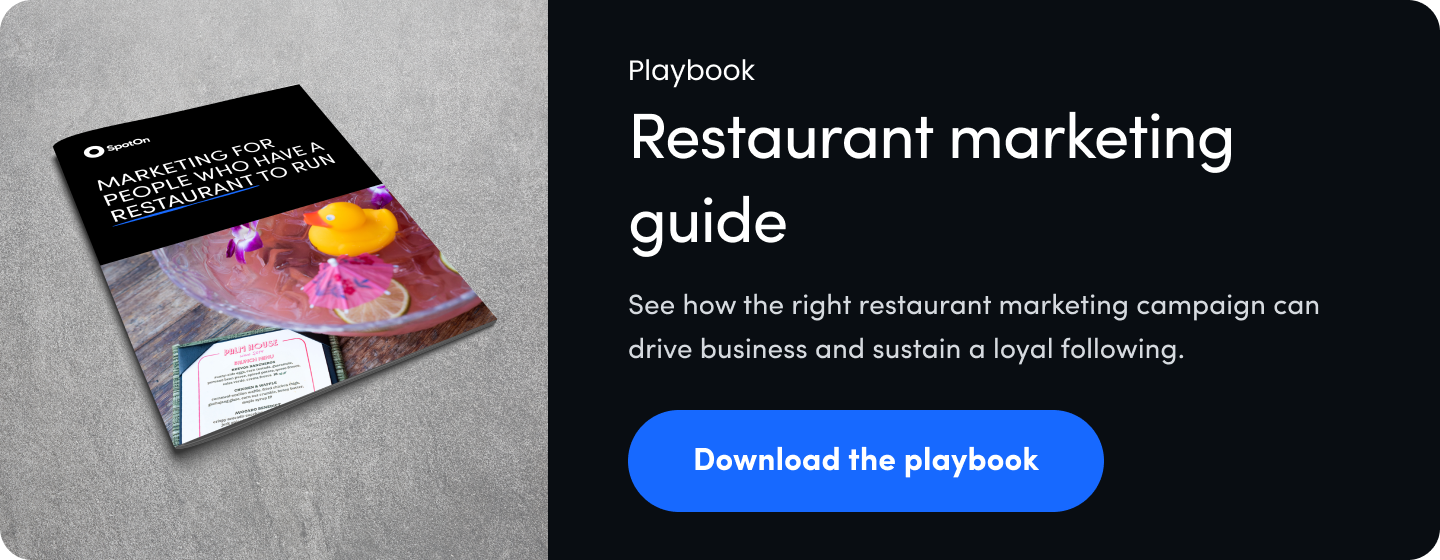
For many restaurateurs, it’s easy to let restaurant marketing sink to the bottom of the to-do list. Sitting down and creating a restaurant marketing plan requires a skill set that can seem antithetical to the heat of the kitchen or sales reports of the back office. Leveraging tools like email marketing software and starting with a pared-down social media strategy provide a great entry point, helping even the most time-strapped operator spread the word about new menu additions and happy hour specials.
Why should I market my restaurant?
Developing a marketing strategy can be rewarding beyond likes, shares, and check-ins. Knowing how to market a restaurant unlocks a powerful tool in the restaurateur’s toolbox, one that helps engage potential guests, encourage repeat visits, and create an enduring brand.
During a time when 90% of operators consider inflation to be a significant challenge for their restaurants, marketing efforts can be a cost-effective way to bring in new guests and drive sales. New restaurants and well-established concepts alike can benefit from a thoughtful marketing strategy to keep guests engaged and coming back for return visits.
"To me, marketing is—if not the most important thing—top three priorities for restaurants.
I learned this firsthand in the nightclub industry, where investing in marketing brought in a new client base. Even when your name is out there, never take your foot off the gas pedal.
At Urban Roast, every guest is an influencer. Whether they have thousands of followers or 50, when they post us on Instagram and tag our location, it helps get our name out there."
- Kamal Azzouz, Managing Partner at Azzouz Hospitality
What is a restaurant marketing plan?
Whether you’ve studied the Instagram algorithm or you’re creating a web presence for the first time, lay a strong foundation with this restaurant guide. We’ve broken restaurant marketing into 6 steps, each with its own subset of steps, to ensure you can develop a brand identity, delight your guests, and encourage increased sales from the get-go.
Here are the topics we’ll cover.
- Telling your restaurant’s story
- Social media marketing
- The benefits of a loyalty program
- Marketing your restaurant’s menu
- Email marketing and personalization
- Managing review sites
Telling your restaurant’s story
The family barbecue joint with a sauce recipe passed down for generations. The chic sushi spot that emerged mid-pandemic. The sprawling patio space where big friend groups gather for affordably priced pitchers. Every restaurant has a story. Telling that story well is crucial to effective restaurant marketing.
Identifying your restaurant story has two main benefits: it defines your brand identity, so your restaurant stands out to potential guests, and it provides a blueprint for future marketing materials. Your restaurant story can be featured in the “about” section of your business website, your Google business profile, printed on your menu, and included in investor pitches and the employee handbook. In short, it's the "why" behind your business that makes every shift about more than an exchange of goods and services.
Take a look at any online marketplace for ordering, reviews, or reservations and it won't hesitate to tell you that there are dozens of restaurants just like yours for guests to choose from. Competition is part of the restaurant industry—and it shows no sign of diminishing. In fact, 47% of operators expect competition from other restaurants to be more intense this year than the year before.
In an increasingly competitive landscape, a compelling story shows potential guests how you stand out.
What makes a compelling restaurant story?
Beginning, middle, end
Every great story has these three elements in common. If opening the restaurant is the main event, what happened before? What sparked the idea to open a restaurant? What were the challenges and successes of opening a restaurant? How did the restaurant opening change lives?
Characters
Anyone who has worked in the restaurant industry knows it's the people who make it remarkable. The team plating in the kitchen and delivering outstanding hospitality on the floor are what help a restaurant shine brighter than a rave review ever could.
Characters will make your restaurant story feel human. Introduce the restaurant owners. Think of who inspired the concept and played an instrumental role in the grand opening. What makes them special? Once you've identified your main characters, describe them and the part they play in your restaurant.
Emotion, not just information
Chronology is a good place to start, but potential guests aren’t looking for a history lesson on your restaurant.
How did you feel during the grand opening? What were the highs and lows of the opening process? Tap into what your restaurant means to you as the restaurant owner, your team, and your community.
Don’t forget the food
Food is essential to your operation. No restaurant can survive on vibes alone. Call out your flagship dishes and describe the inspiration behind them. Food also evokes feelings and memories, both of which will help potential guests connect to your story.
Dig through the photo archives
You want to show potential guests where you’ve been and give them a sense of what it took to open your restaurant. Photos of your team and your restaurant’s evolution create a behind-the-scenes look into your business. Just be sure your photos are high quality and optimized for your website. Photos like these are also great for sharing on social media, though you'll want to make sure they're the correct size and resolution for the platform on which you're sharing.
Create a professional website
You've developed a narrative and gathered beautiful photos to draw people in. If you're opening a new restaurant, you'll need a website to serve as the cornerstone of your restaurant marketing strategy. Alternatively, you could be looking to give your restaurant marketing efforts a refresh, in which case updating your website is a great place to start.
Your restaurant's website serves as the landing page for paid digital marketing, like Google ads, and a destination for potential guests seeking out more information. It's home to your online ordering page, menu, and any online booking platforms guests might use to reserve a table.
While an authentic narrative should be the centerpiece of your website, search engine optimization, or SEO, is necessary to ensure potential guests will discover your website.
SEO optimization doesn't need to be a costly or extensive endeavor. You can use a free keyword research tool to find the search terms potential guests are using and weave them into your website's text.
For example, if you run a brewery, people might be searching for "brew pub," "craft beer," and "microbrewery." Some keywords are more competitive and others are easier to rank for. You’ll also want to make to include your city or town name prominently on your website so you show up in local searches. Think of SEO optimization as part of your restaurant's intended marketing activities, and put aside time each quarter to make sure your website is up to date and performing well.
Capturing local press opportunities
While the restaurant marketing landscape has changed drastically with the rise of social media, print and online publications can still play an important role in your restaurant marketing strategy.
Reach out to local publications to share the news of your new concept. If you're offering something unique, on-trend, or trailblazing for the area, there's a chance they will want to cover your restaurant in a story. This could be as brief as a short news bulletin, or perhaps an interview with the restaurant owner or executive chef. It could even mean television or online video coverage.
In advance of your grand opening, you'll want a well-written background story of your restaurant at the ready. This will be an important part of your press release, which will let media outlets know the what, when, where, who, and why of your restaurant. You can also include some menu highlights and previews of events and specials your restaurant might hold in the future.
Establishing your social media presence
Between the literal and figurative fires that operators need to put out on a daily basis, creating social media content feels low priority. Plus, all it takes is a few missteps and your social media profile could be doing more harm than good. But social media platforms can be a valuable source for restaurant marketing ideas and a cost-effective method for running marketing campaigns.
While many restaurant owners think constant posting across all social media platforms is the best strategy for finding new customers, that's not necessarily the case. It's more effective to focus your restaurant's social media marketing strategy by identifying your target audience and their preferred platforms.
What are the best practices for social media marketing?
"Ask yourself: what does a guest look for when they choose a restaurant? This may include a well-maintained Google page, nice pictures, and social media on TikTok and Instagram.”
– KwangHo Lee, Momoya
Invest more into fewer platforms
A new local restaurant opens its doors. They're balancing all the demands of opening a new business while trying to keep up a Facebook, TikTok, Snapchat, Instagram, and Twitter account, not to mention their online reviews and business page.
They're on a shoestring marketing budget, with the restaurant owner sharing posting responsibilities with his teenage daughter. As more customers come through the door, it's a hard act to keep up. Their restaurant's marketing strategy lapses and suddenly their dormant, outdated social media pages are doing more harm than good.
To avoid this dilemma, start by identifying your target audience. If most of your guests are older, they might prefer to connect with you on Facebook. If you're looking to attract tourists or a younger crowd, TikTok and Instagram will be a more natural fit.
While each site has a unique algorithm that determines a post's success, there are general rules for restaurant marketing success on social media. You should think of TikTok content as entertainment instead of traditional social media. If you're creating content for TikTok, it will perform well on Instagram, but not necessarily vice versa.
Encourage guests to post your restaurant and tag you, so you can repost their content. The popularity of smartphones means that high-quality photography is more common than ever. If your guests are taking appealing photos of your signature dishes, you'll want to share them.
It’s about more than your menu. Successful restaurant marketing puts intention behind every detail. Selfie walls, for example, are another popular tool to gain more visibility on social. Place neon signs with clever slogans, artful decor, or creative seating in your restaurant and encourage guests to take photos to share on their accounts. Make sure your handles are visible in the physical spaces of your restaurant such as on menus, table cards, at the host desk, and emblazoned on mirrors.
Decide on awareness or conversion
Before you start posting on social media, determine what you're trying to achieve. An effective marketing strategy isn't all about gaining followers and racking up likes. Consider whether you're trying to reach new customers or increase repeat business.
Social media can be instrumental in gaining brand recognition and increasing sales by converting potential customers. But different goals require different strategies and measures of success.
If you're looking to grow awareness and brand recognition, followers are a helpful metric. But you also want to consider link clicks and shares. These show that people aren't just scrolling past your content, but actually engaging with it.
Giveaways are one popular method for growing your follower count. Invite your social media followers to tag their friends for a chance to win a free meal, special item, or exclusive merch. It's a marketing strategy that rewards your most loyal customers and spreads awareness of your restaurant brand.
Social post ideas to increase brand awareness
- Share this post: Encourage your followers to re-post a photo or graphic for a chance to win a giveaway. Take care that the post you’re asking them to share is visually appealing and contains a mention of your brand.
- Tag a friend: Ask your followers to tag a friend, or multiple friends, to enter the giveaway. You can also require all accounts to follow your brand in order to be eligible.
- Post a photo for a chance to win: When your guests post photos of your restaurant and food, there are two big benefits. You gain a new audience for your brand through your guests' followers as well as new content that you can re-post. Invite your guests to post the most impressive cheese pull, gorgeous cocktail photo, or wildest place they’ve eaten your take-out. The only difficult part of this campaign is picking a winner!
- Start a conversation: While a lot of social content is visual, you can also take the opportunity to get people talking. Pose a question asking for people’s favorite dish, memory, or person to visit your restaurant with. You can either ask that people share their stories in the comments or post on their own account and tag your brand.
- Re-post follower content: When a guest tags you in their social post, re-post it to your account. This creates a connection with your guest, helping them feel acknowledged, and encourages others to post content from their visit.
Social media can also be a powerful tool for increasing sales. A marketing campaign puts your restaurant's brand identity and unique menu items front of mind for potential customers. Where in the past many restaurants may have been beholden to a direct mail campaign or advertising in local magazines, digital marketing with social media means a more nimble restaurant marketing strategy.
Use your social presence to spread the word about your loyalty programs, special promotions, and upcoming events to get more customers through the door for repeat business. The fast pace of social media means you can even offer flash deals to your followers that give them a discount or free item if they come in within the next couple of hours. Or, ask that they show a certain social post to get a deal on their order.
Just ensure that your front-of-house staff is well aware of any active social campaigns and that you set clear conditions for your guests in the caption. You don't want to set people up for disappointment after seeing dated content, so always keep your social profile up-to-date.
Social post ideas to increase sales
- Share an exclusive discount: Post a special code exclusive for your social followers. This can either be redeemed online or shared for in-store purchases, depending on where you’re trying to increase sales.
- Link to your online ordering page: Make sure your followers know where to find your menu and ordering site. Link the site in your bio, or feature it as part of your post, so your followers can take action after viewing your enticing posts.
- Donate a percentage of sales: Donation campaigns can be a great way to increase sales and rally your followers around an important cause. Publicize a donated percentage for sales during a specific time period or on a particular item.
- Promote a flagship item: Every restaurant’s menu has anchor items that feel quintessential to your brand and story. Encourage followers to post photos of that item, or start a social campaign around the item, to shine a light and hopefully increase sales.
- Spread the word about specials: Your menu is always changing. It’s a good thing—it helps you adapt and stay profitable. Drum up excitement by posting about specials. Let your followers know how long they’re around or if there’s a discount or special deal.
Stick to a content plan
Once you've determined which social media platforms are a fit for your restaurant marketing strategy, you can create a content plan for your marketing channels and start identifying ways to track success. How often should you be posting as part of your restaurant marketing efforts? A good rule of thumb is 4-5 times a week on Instagram, in a combination of photos and videos, which you can always cross-post to Facebook.
Be wary not to overwhelm your followers with posts, or you risk losing them. Take note of what your target audience finds engaging by tracking likes and shares, and use this to inform restaurant marketing ideas going forward. On Instagram and Facebook, you can even use the poll feature to get a temperature check on what your followers would like to see from your restaurant's page.
You can also dig into your follower analytics to better understand your follower demographics, what kind of content they prefer, and when they're online. This can help you determine when and what to post.
Ask yourself: What's in it for them?
Bombarding your audience with one food picture after another may seem like a natural marketing strategy. You're in the restaurant business after all. But an effective restaurant marketing plan incorporates compelling stories, exciting updates, and exclusive offers, not just pizza cheese pulls.
As you're planning out your content, take advantage of holidays like Mother's Day and National Pasta Day to inspire your posts. Utilize hashtags to give your post more visibility and relevance. You can also play with social media trends and memes, but be cognizant that these fade quickly and lack longevity. You don't want to jump on a trend as it's halfway out the door. Return to the story at the core of your restaurant to develop content that is authentic and timeless.
Once you've developed content that your target audience wants to consume, publicize your social media profiles. Ensure your social icons are visible on your website. If you offer a customer loyalty program, reward new customers for following your restaurant on social. You can also spread the word through email marketing.
Influencer marketing
Many large chains and major brands use social media influencers to promote their restaurants and products in an authentic, trusted voice. There’s no reason your restaurant can’t do the same—just on a smaller scale. While you might want to "go viral," it can be a difficult phenomenon to reverse engineer. Instead, finding "nano-influencers," or people who post about local businesses can be a more cost-effective restaurant marketing strategy while helping increase awareness.
Find people who are already superfans of your restaurant by searching your restaurant online and looking at review sites. You can see if any of your existing followers are raving about you already, and whether they have large followings themselves. You might encourage these folks to re-post upcoming marketing campaigns so they can spread the word to their network.
If you're using "nano-influencers" to spread the word about your restaurant, you might want to use your restaurant's marketing budget to promote the post. That way, it will reach a larger audience and hopefully get more guests through the door.
Keep in mind, if influencers are part of your restaurant marketing strategy, you'll want to choose people who have an authentic relationship with your brand. Influencer marketing can backfire if the messaging feels artificial or the content feels too much like a traditional advertisement.
Social media and your restaurant marketing budget
Social media posts fall into two categories: paid content and organic content. Organic content, which is free, is a great way to cultivate community among your guests. On the flip side, paid content is promoted in local online ads. The goal is to increase sales and convert potential guests into customers.
Paid content often funnels followers to your restaurant's online ordering platform, so they can browse your menu and (hopefully) place an order. Social content is just one line item of your restaurant marketing budget, which might also include Google ads, local events, and other forms of restaurant advertising.
How to start a loyalty program
In a sea of options, why would guests return to the same spot every week? Enter loyalty programs. They're one way to increase customer retention and show your most loyal customers that you appreciate their business. Plus, they're extremely popular with guests.
According to the National Restaurant Association 2023 State of the Restaurant Industry, 8 in 10 consumers say they would likely participate in a loyalty and reward program for frequent customers if it was offered by a restaurant in their area that they patronize. People like to feel special. Restaurant dining can be a splurge and loyalty can either help offset the cost from the guest's perspective, or make them feel valued.
Rewarding customer loyalty with free items, VIP treatment, and points for purchase helps increase foot traffic and online sales. Big brands, like Starbucks and Chipotle, invest heavily in their rewards programs with custom apps and frequent discounts. But a local restaurant can also incorporate customer loyalty into their marketing strategies.
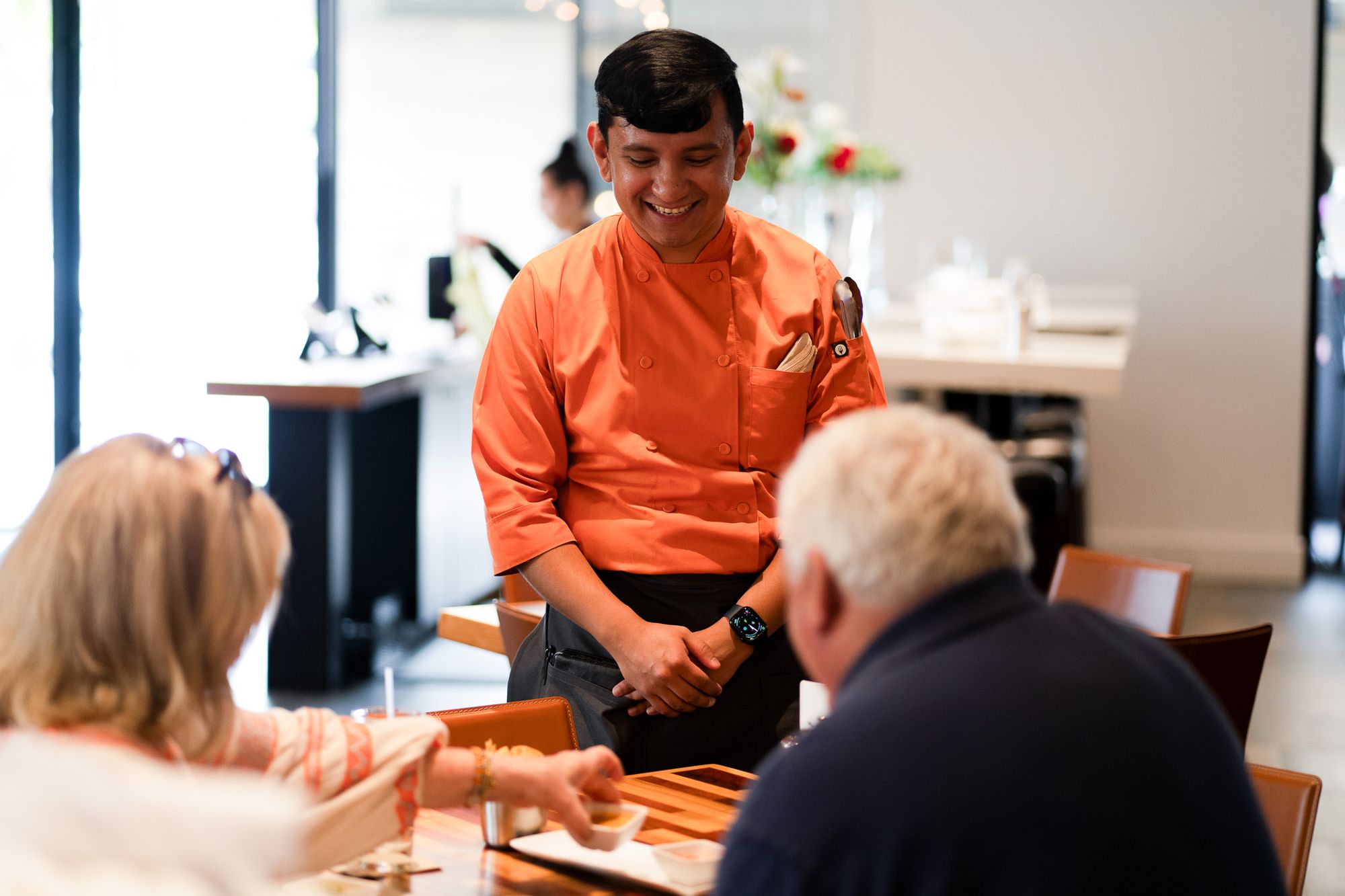
Point system vs surprise & delight
There are two main ways to think about customer loyalty. A point system is a consistent offering that regular customers can use, earning points for each visit or dollar spent that they can eventually redeem for free or discounted items. A surprise & delight strategy offers intermittent deals to drive traffic when needed.
Many restaurants are subject to the 80/20 effect, where 80% of your business comes from 20% of your guests. While many restaurant owners might feel a natural inclination to draw in new customers, loyalty programs that reward repeat customers are often more profitable over the long term.
Loyalty has boomed in recent years, leading large chains and local spots to get creative with their offerings. Think outside of the "free appetizer" box by offering merchandise as a loyalty reward. T-shirts, hats, koozies, and other small branded items both incentivize guests to patronize your restaurant and help put your brand out in the world for all to see.
Experiences, like behind-the-scenes access and exclusive events, can also be part of your loyalty strategy. Dining clubs, where guests are members of a club that gets exclusive access to the restaurant's offerings, are making a comeback. While these membership clubs are often subscription-based and paid for by the guest, free loyalty offerings can mimic that same exclusivity with secret happy hours or menu specials.
Marketing strategies for your loyalty program
There's little point in offering a rewards program if none of your customers know about it. Loyalty offerings should be a central focus of your restaurant's marketing efforts. Spread the word through email marketing, digital marketing, and even a small direct mail campaign.
In all successful loyalty programs, the sign-up process is as frictionless as possible. When your point-of-sale integrates directly with your customer loyalty software, new customers can enroll at checkout and start redeeming rewards right away.
Loyalty can also help you gather customer data and build up your customer database, which you can use in later marketing campaigns. Be sure to select a tech partner that lets you own your own customer data, rather than holding it hostage.
Measuring loyalty success
As with all restaurant marketing campaigns, you'll need to set goals and track key metrics to see whether your marketing efforts have been successful. For loyalty, this can be a certain amount of sign ups per month, dollar amount of loyalty spend, or visits from repeat customers.
Loyalty can also help you boost guest engagement. Offer points to convert online ordering customers to on-premise diners, or incentivize guests to rate your restaurant on review sites. Tracking this and other important marketing campaign data from one central dashboard can help you time on admin and ensure that your marketing initiatives are actually working.
Once the amount spent by loyalty customers exceeds the dollar value of redemptions, you'll know that loyalty is having a meaningful impact on your monthly sales and revenue.
Marketing strategies and your restaurant’s menu
Your front-of-house has great customer service down to a science. Marketing efforts are bringing in new customers and the online reviews are glowing. But the restaurant industry is fast-paced and if you're not adapting, there's a risk of falling behind.
How to keep things fresh and exciting when there are only so many ways to offer a happy hour deal or take photos of the pastry case?
Limited time offers (LTOs)
Urgency motivates people. Daily, weekly, and monthly specials or limited edition collaborations are common restaurant marketing strategies for small businesses and large chains alike (McRib, anyone?). Limited edition menu items can take advantage of seasonal produce, incorporate guest feedback, or take advantage of local events and upcoming holidays to boost foot traffic.
The holiday season in particular is a time of indulgence—something to keep in mind as you develop your restaurant marketing plan. Guests are likely to spend more, so you can pitch menu items with higher price tags and offer unique set menus and drink specials.
If you're located among a vibrant local business community, leverage the recognition and success of your peers by utilizing local products or suppliers. Make a nearby farm's free-range chickens or a microbrewery's beer the centerpiece of your LTO. After all, a rising tide lifts all ships.
LTOs are more than a clever marketing campaign. They can be a boon to your kitchen, too, helping cross-utilize existing ingredients and increasing your menu's profitability. Encourage the person in charge of your restaurant marketing strategies to work closely with your culinary team to use a menu engineering matrix to develop LTOs.
Limited time offers won't move the needle on your monthly sales unless your guests know about them. Share updates through email marketing, direct mail, and other marketing channels. Using influencers to create a restaurant marketing campaign can help spread awareness of your new offer. For example, Erewhon, the California-based upscale grocery store, has partnered with celebrities like Hailey Bieber to inspire their smoothie menu to great online marketing success.
Writing a compelling menu
Restaurants are sensory experiences. Between the sounds, smells, and tastes, it's easy to assume that words don't matter. But everything your guest sees is an opportunity to make a good impression and distinguish your restaurant from the competition. Your restaurant marketing should go beyond social posts and Google ads to keep guests hooked whether or not they're on-premise.
One way to showcase your menu is to show how your menu items reflect existing trends. For example, the National Restaurant Association What's Hot Culinary Forecast 2023 found that shareable food, charcuterie boards, and so-called "pedigreed proteins" or premium, sustainable cuts of meat are all having a moment.
Your menu descriptions should highlight the main selling points of each menu item, whether that means tapping into their sustainable source, unique flavor profile, or inspired back story. If the meatballs are Grandma's recipe, let your guests know. Maybe Grandma didn't plan to be the inspiration behind your restaurant marketing strategies, but if it helps you tell a story, it's worth bringing her in.
Lastly, if your on-premise or online ordering menu includes photos, ensure these are high-quality images that paint your dishes in the best light possible. Your online ordering page is one of your many marketing channels and should be updated in lockstep with your restaurant marketing plan.
Consider a restaurant POS system that works in sync with your online ordering, so you can update menu items in minutes and ensure prices and descriptions are accurate. If your guests have the option to order direct or order from a third-party platform, always encourage direct ordering. You’ll save on commission fees and gain access to guest data for re-marketing purposes. Spread awareness with a specific marketing campaign encouraging guests to order direct.
The menu refresh
Like a French baguette left on the kitchen counter, your menu gets stale over time. Incorporating guest feedback and monitoring negative reviews can help you get a read on what's working and what's not. So much of restaurant marketing is touting what's new and exciting, but there are only so many marketing strategies for selling the same familiar sirloin steaks or soup-and-sandwich combos.
Refresh your menu to reflect seasonal produce or attract a different kind of clientele. Keeping your menu vibrant can also help with customer retention, encouraging lapsed guests to come back in to try the new menu.
Email marketing efforts and personalization
Gone are the days of direct mail as the crown jewel of restaurant marketing. The ubiquity and ease of email marketing make it the clear choice for operators looking to boost guest engagement and increase sales. But putting together a solid email marketing plan requires more than customer data and a clever subject line.
Creating an email marketing plan
The benefits of email marketing are immense, but like all restaurant marketing strategies, it requires a regular cadence to remain relevant and keep your brand top of mind for potential guests. If you're new to email marketing, consider the humble monthly newsletter.
Everyone from local coffee shops, to clothing brands, to pet groomers, seems to offer a monthly newsletter nowadays. The goal is to keep your potential customers informed about new happenings, changes to your hours or operations, and share content that will get them excited about supporting you.
Once you've established a rhythm, you can use email as a tool to connect with your most loyal guests and share stories, photos, and deals. If you’re running a loyalty program, you can also set up automated emails to send limited time offers to guests on their birthday or when they haven’t visited in a while. Just remember, not every email should focus on increasing sales. Perhaps you're doing a pop-up at a local farmer's market or hosting a fundraising event.
In addition to following email marketing best practices, you’ll want to keep an eye on how your emails are performing. Monitor the open rate and click-through rate of your marketing efforts to ensure your guests are engaging with your content and not just looking for the unsubscribe button.
Targeting your audiences
Customer data is the cornerstone of successful online marketing. Ensure guests have multiple opportunities to share their email addresses and that they understand the benefits of connecting with you.
You can offer Wi-Fi, and collect guest email addresses in exchange for Wi-Fi access. With some providers, your restaurant point-of-sale system will automatically collect contact information in order to send an email or text receipt. Loyalty is another method. For your more old-school guests, you might place a sign-up sheet near the register or hold a raffle in which email information is required.
Managing review sites
The ubiquity of review sites means everyone's a critic. If you're not monitoring your online reviews, you run the risk of potential guests seeing unaddressed negative reviews that discourage them from supporting your business. On the flip side, positive online reviews can be some of the most effective restaurant marketing materials at your disposal.
The first step to owning your restaurant's online reputation is claiming your business on review sites. This includes Google Business Profile, Yelp, and TripAdvisor. You might also receive reviews on your Facebook page.
Once you've claimed your business online, you'll want to regularly monitor review sites. This can also benefit your operations, by providing direct guest feedback that you can drive operational improvements, such as improving your menu or team management. Review management software makes it easy to monitor all your online reviews in one place, giving you a bird's eye view of what people are saying about your business.
Responding to reviews
Modern technology means the customer experience expands well beyond the four walls of your restaurant. The customer experience happens during online orders, social posts, emails, and especially review websites.
Responding to positive reviews is straightforward—thank your guest for their kind words and encourage them to come back soon. Responding to negative reviews requires a bit more tact. When faced with a less-than-rosy review, you want to demonstrate that you hear their constructive feedback, apologize for the subpar experience, and potentially suggest ways you can redeem the situation if it's appropriate.
It can be frustrating when negative reviews come out of left field. Often, all signs point to an excellent guest experience and a tough review can feel hurtful and unfair. Reviews have always been and will always be part of the restaurant industry, no matter the different forms they take.
Whether it's in newspaper print or Facebook comments, successful restaurant marketing shines a light on the positive reviews and takes the not-so-positive in stride. Onward!
Want restaurant marketing success? Be authentic.
You don't need a big budget, a sophisticated marketing team, or an hours-long brainstorming session to run a successful restaurant marketing campaign.
With a clear picture of what your restaurant is offering, some time-saving email marketing technology, and plenty of high-quality photos, you can help potential guests find your restaurant and encourage existing ones to come back soon.
Don't forget that restaurant marketing is an ongoing project. While you don't need to be constantly running multiple campaigns, schedule quarterly check-ins to maintain your restaurant marketing plan and assess what needs updating.
Now, get out there and spread the word—by social post, email, special deal, or even carrier pigeon. You're doing incredible work. Go shout it from the rooftops.
